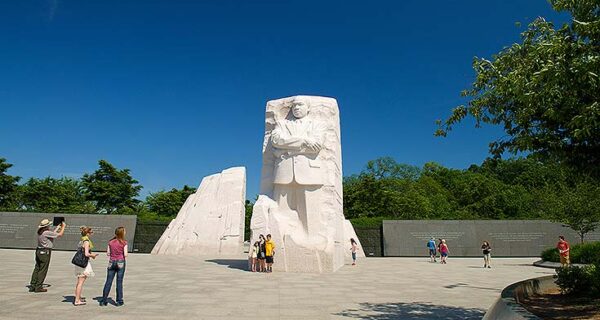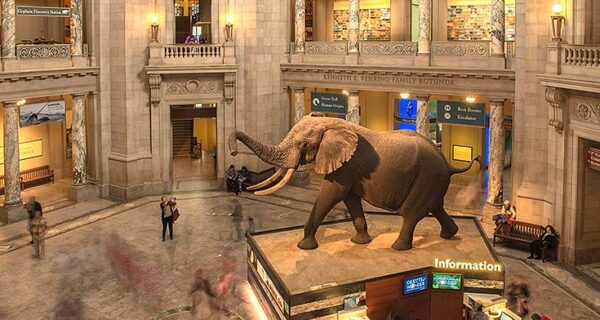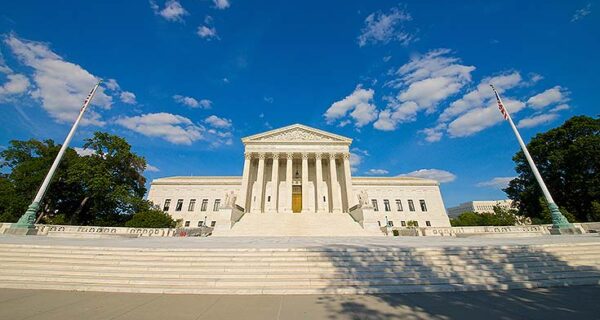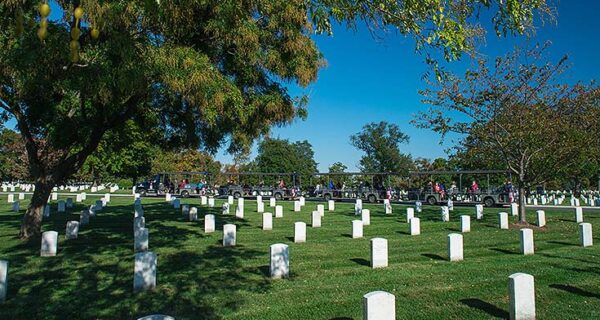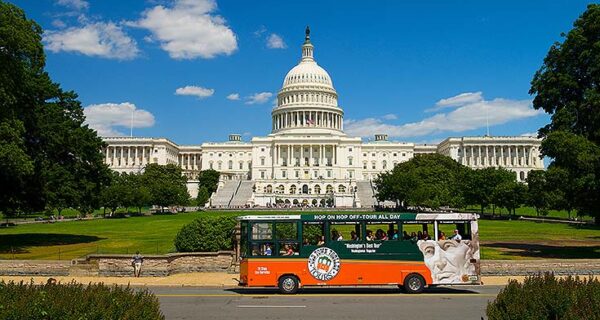Some of the top educational sites include the National Mall’s monuments and memorials, such as the Lincoln Memorial and the World War II Memorial. Smithsonian museums, including the National Museum of American History and the National Museum of Natural History, provide hands-on learning experiences. Historic sites like Arlington National Cemetery and government buildings such as the United States Capitol offer valuable insights into American history and governance. Including these sites in Washington, D.C., trips for schools ensures students engage with diverse and important parts of the nation’s heritage.
-
Our nation’s capital is a special place for school trips because it brings history and government to life. The city is full of important landmarks and museums that help students connect what they learn in class to real places.
A well-planned Washington, D.C., school trip lets students explore key parts of America’s story and understand how government and history still affect us today. It encourages curiosity and helps make learning more meaningful. This guide is for parents, teachers, and group leaders who want to plan D.C. field trips that are both enjoyable and educational.
-
What Can Students Learn From Washington, D.C.’s Iconic Monuments and Memorials?
Visiting the National Mall’s monuments and memorials gives students a chance to connect with important moments in American history during their Washington, D.C., school trip. These places tell stories about patriotism, leadership, and sacrifice that make lessons come alive.
The Lincoln Memorial invites students to think about unity and equality. They can read famous speeches carved into the walls and learn about President Lincoln’s leadership during hard times. Nearby, the Washington Monument honors the first president and offers a great view of the city’s layout and history.
War memorials like the World War II Memorial, Korean War Veterans Memorial, and Vietnam Veterans Memorial give students space to remember the sacrifices made by soldiers. Each one tells a different story about the challenges of war and how it affected the nation. Students can reflect on the bravery, struggles, and hopes of those who served.
Other memorials share important ideas, too. The Martin Luther King Jr. Memorial celebrates the fight for civil rights and justice. The Thomas Jefferson Memorial shows students the ideas of liberty and democracy that helped build America. The Franklin Delano Roosevelt Memorial teaches about strong leadership during tough times like the Great Depression and World War II.
Including these monuments in Washington, D.C., trips for schools gives students a chance to see history up close. These stories help students connect to America’s past and inspire them to understand the sacrifices and ideas that shaped the nation.
-
How Can Smithsonian Museums Enhance Washington, D.C., School Trips?
The Smithsonian museums play a big role in many Washington, D.C., trips for schools. They give students a chance to explore science, history, culture, and art in ways that make learning interesting and hands-on. Because admission is free, these museums are a great fit for Washington, D.C., school trips that need to stay within budget.
At the National Museum of Natural History, students can discover exhibits about the Earth’s geology, ancient fossils, and the variety of animal life from around the world. The interactive displays and live demonstrations help make complex subjects easier to understand and keep students curious and engaged.
The National Air and Space Museum shares stories of human flight and space exploration. Students can see real airplanes, rockets, and spacecraft, including historic pieces like the Wright brothers’ plane and Apollo capsules. The museum also offers hands-on science activities and flight simulators that bring the history of aviation to life.
For a look at America’s story, the National Museum of American History displays important artifacts such as the original Star-Spangled Banner and items from American pop culture. Exhibits cover a wide range of topics, including inventions, transportation, and the struggle for civil rights, helping students see how the country has evolved over time.
The National Museum of the American Indian teaches about the cultures, traditions, and histories of native peoples throughout North and South America. The museum features art, storytelling, and interactive exhibits that offer valuable lessons about cultural diversity, respect, and heritage.
The National Museum of African American History and Culture offers a deep look at African American history, culture, and achievements. The exhibits include everything from slavery and the Civil Rights Movement to music, sports, and politics. Because of its popularity, groups planning Washington, D.C., trips for schools should arrange visits well in advance.
Art lovers can visit the National Gallery of Art, which displays a wide range of paintings, sculptures, and decorative arts from different periods and regions. The museum’s collection includes famous works by artists like Leonardo da Vinci, Rembrandt, and Georgia O’Keeffe. Students can learn about artistic styles and how art reflects culture and history.
Including these museums on your D.C. field trips gives students real-world experiences through exhibits and artifacts that connect what they learn in class to something tangible.
-
How Can Students Experience Government and Civics in Washington, D.C.?
One of the most valuable parts of Washington, D.C., trips for schools is the chance to see government and civics in action. Visiting some of the important buildings listed below helps students understand how the country’s democracy works and the role each branch plays.
The United States Capitol Building is where laws are made, debated, and passed. Guided tours take students through historic chambers and impressive halls where Congress meets. They learn about the legislative process, see artwork honoring past leaders, and understand how citizens’ voices influence government. It’s a central stop on many Washington, D.C., school trips.
Nearby, the Library of Congress is the largest library in the world, holding millions of books, manuscripts, and recordings. Its stunning architecture includes murals and sculptures that tell stories of American history and culture. Students can explore exhibits that highlight the importance of knowledge and learning in a democracy.
The National Archives Museum houses the original Declaration of Independence, Constitution, and Bill of Rights. Viewing these documents allows students to connect deeply with the founding ideas of the nation. The museum also offers exhibits on important legal and historical events, making it a key site for any D.C. field trips itinerary.
At the Supreme Court of the United States, students learn about the judicial branch and how the courts interpret laws. Though courtroom access is limited, many groups attend educational programs or view the building’s grand exterior.
The White House is the president’s home and workplace. While tours inside the White House require special arrangements and are limited, students often visit nearby Lafayette Square or the White House Visitor Center to learn about the executive branch’s role.
Including these stops in your Washington, D.C., trips for schools helps students see how government functions and builds a clearer picture of their role as citizens in a democracy. These experiences support lessons in civics by showing students how leaders work to serve the country and uphold its values.
-
What Makes Historical and Cultural Sites Essential for Washington, D.C., School Trips?
Visiting historical and cultural sites helps students understand the people and events that shaped America. These places tell stories that bring history to life, making lessons more meaningful during any Washington, D.C., school trip.
Ford’s Theatre and Petersen House offer a moving look at a key moment in the nation’s past. At Ford’s Theatre, students can walk through the place where President Abraham Lincoln was shot and hear stories about that tragic day and its effects on the country. Just across the street, the Petersen House, where Lincoln actually died, shows what life was like in the 1800s and explains how medical care worked at the time. These sites provide a chance to learn about history and humanity in a personal way.
The International Spy Museum adds excitement to D.C. field trips with its fascinating exhibits on spying and secret missions. Students discover how spies use codes, gadgets, and clever thinking to gather information. The museum also covers how intelligence work has shaped important events in world history. It’s a unique stop that mixes learning with mystery and hands-on fun.
Arlington National Cemetery is a place to honor those who served the country. Guided tours with Arlington National Cemetery Tours help students understand the history of the military and the sacrifices made by veterans. Visitors see famous monuments, gravesites, and the Tomb of the Unknown Soldier. The cemetery also includes the graves of presidents, astronauts, and heroes from many wars.
The U.S. Botanic Garden offers a peaceful break from the busy city. Students explore a wide range of plants from different climates and learn why plants matter to people and the environment. The garden teaches about conservation and the science behind growing and protecting plants. It’s a great way to add nature and science learning to any Washington, D.C., school trip.
Adding these historical and cultural sites to your D.C. field trips deepens students’ understanding of history, culture, science, and respect, making the trip memorable and educational.
-
How Can You Best Plan a Washington, D.C., Field Trip?
Planning a successful Washington, D.C., school trip takes careful attention to logistics. Thoughtful preparation helps make the visit smooth, educational, and enjoyable for everyone involved.
Transportation plays a big role in managing time and energy during your trip. Old Town Trolley vehicles provide a convenient and comfortable way to see many of the city’s top attractions. Their friendly guides offer live narration filled with stories and facts that bring history to life. While Old Town Trolley Tours® doesn’t cover Arlington National Cemetery, booking a dedicated tour for the cemetery through a trusted operator, like Arlington National Cemetery Tours, ensures respectful and informative access. Combining trolley tours with other transportation options helps groups make the most of every moment.
Choosing the right accommodation matters too. Look for hotels with group-friendly rates and easy access to public transit or shuttle services. Staying near the National Mall or downtown can save travel time. Booking early often means better rates and room availability for large groups.
Smart budgeting helps stretch every dollar. Many Smithsonian museums are free, which is a major plus for Washington, D.C., trips for schools. Look for discounts on group tours, meals, and attractions. Planning meals and snacks ahead of time keeps students energized and helps avoid unexpected expenses.
Advance planning and booking are crucial. Some popular spots, like the National Museum of African American History and Culture, require reservations months in advance. Many tours and museums recommend early booking to skip long lines and guarantee entry. Planning your itinerary with this in mind reduces stress and maximizes your educational experience.
Aligning your trip with classroom goals ensures strong educational integration. Coordinate with teachers to choose sites and programs that support curriculum objectives. Many museums and landmarks offer educational materials and tailored group tours that enhance student learning.
Health and safety remain top priorities. Stay updated on site-specific guidelines and current health advice. Prepare students for walking and outdoor time with comfortable shoes, water, and sun protection. Keeping everyone safe and comfortable ensures a positive experience.
The best time to visit is typically spring or fall when the weather is mild and crowds are smaller. Summer can be warmer but offers longer days and special events. Planning your trip during less busy times can make for a more enjoyable visit to monuments, museums, and parks.
Careful planning and using trusted services and tour operators make Washington, D.C., trips for schools smooth, engaging, and memorable for students and chaperones alike.
-
Why Are Washington, D.C., Field Trips So Valuable for Students?
Washington, D.C., stands out as a top destination for Washington, D.C. trips for schools, offering a unique mix of history, culture, and government that brings classroom lessons to life. Students have the chance to visit iconic monuments, explore world-renowned Smithsonian museums, and reflect at powerful sites like Arlington National Cemetery. Planning a Washington, D.C., school trip provides students with hands-on experiences that deepen their understanding of the nation’s story and civic values. No matter the age or interests of your group, Washington offers a range of educational opportunities that inspire learning and spark curiosity at every turn.
FAQs
Yes, many of the Smithsonian museums offer free admission, making them excellent choices for schools working within tight budgets. Outdoor sites, including the National Mall’s monuments and memorials, as well as Arlington National Cemetery, are also free to visit. These places offer rich educational experiences without added costs. Planning Washington, D.C., school trips around these free sites can help schools maximize learning while keeping expenses low.
Planning a Washington, D.C., school trip well in advance is essential to secure access to popular museums and tours. Some sites, like the National Museum of African American History and Culture, require reservations several months ahead due to high demand. Early planning also allows time to arrange transportation, accommodations, and educational programming. Schools that start their preparations early often find their D.C. field trips run more smoothly and can include a fuller range of activities.
To stretch your budget, focus on free Smithsonian museums and outdoor monuments, which provide rich educational content at no cost. Look for group discounts on transportation options such as Old Town Trolley Tours® and consider booking accommodations with group rates. Planning meals and snacks ahead of time can help control costs during the trip. Thoughtful scheduling to avoid peak tourist seasons may also reduce expenses. These strategies help make Washington, D.C., trips for schools affordable and effective.
For younger students, the National Museum of Natural History offers engaging, hands-on exhibits that bring science to life. Older students often find the National Air and Space Museum and the National Museum of American History especially interesting for their detailed displays and historical artifacts. The National Museum of African American History and Culture offers a powerful educational experience for middle and high school students and requires advance reservations. Careful planning of D.C. field trips to match age groups ensures that each visit is both enjoyable and meaningful.



